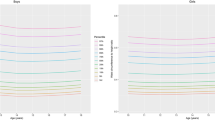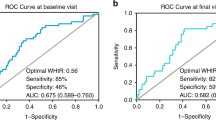Abstract
Objectives:
To construct waist-to-height ratio (WC/Ht) reference values and centile curves for Japanese children and to compare these references with those from other countries.
Methods:
The 1978–1981 national survey data were used for reference and the 1992–1994 national survey data were used for validation. The former included 19 233 children, and the latter included 10 446 children, aged 6 to 18 years. Waist circumferences (WC) were measured at the level of maximum waist narrowing in girls, and at the level of the top of the iliac crest in boys. Age- and sex-specific reference curves were fitted with the LMS method. Cut-off points were arbitrarily set at 85th, 90th, 95th and 97th centiles, and compared with WC/Ht 0.50.
Results:
The proportion of children in whom WC/Ht exceeded 0.50 was 18.7% of boys and 1.9% of girls, whereas the proportion of children exceeding 90th centile was 42.4% for boys and 17.3% for girls. The reference values decreased with age in girls but varied by age without a clear trend in boys.
Conclusions:
The first reference values for WC/Ht are provided for Japanese youth based on the 1978–1981 national survey data. These curves are age- and sex-dependent, precluding the use of universal cut-off for WC/Ht of 0.50.
This is a preview of subscription content, access via your institution
Access options
Subscribe to this journal
Receive 12 print issues and online access
$259.00 per year
only $21.58 per issue
Buy this article
- Purchase on Springer Link
- Instant access to full article PDF
Prices may be subject to local taxes which are calculated during checkout


Similar content being viewed by others
References
Flegal KM, Shepherd JA, Looker AC, Graubard BI, Ogden CL, Borrud LG et al. Comparisons of percentage body fat, body mass index, waist circumference, and waist-stature ratio in adults. Am J Clin Nutr 2009; 89: 500–508.
Savva SC, Tornaritis M, Savva ME, Kourides Y, Panagi A, Silikiotou N et al. Waist circumference and waist-to-height ratio are better predictors of cardiovascular disease risk factors in children than body mass index. Int J Obes 2000; 24: 1453–1458.
Ashwell M, Cole TJ, Dixon AK . Ratio of waist circumference to height is a strong predictor of intra-abdominal fat. BMJ 1996; 313: 559–560.
McCarthy HD, Ashwell M . A study of central fatness using waist-to-height ratios in UK children and adolescents over two decades supports the simple message—‘keep your waist circumference to less than half your height'. Int J Obes 2006; 30: 988–992.
Anzo M, Inokuchi M, Matsuo N, Takayama JI, Hasegawa T . Waist circumference centiles by age and sex for Japanese children based on the 1978-1981 cross-sectional national survey data. Ann Hum Biol 2015; 42: 56–61.
Japanese Standards Association Report of Japanese body size measurement to establish sizing systems for garments from 1978-1981 1984. in Japanese.
Research Institute of Human Engineering for Quality Life Japanese body size data 1992–1994 1997. in Japanese.
Japanese Ministry of Education, Culture, Sports, Science and Technology. Report of the 1978-1981national growth survey of normal Japanese children, 5-17 years of age. Tokyo, Japan, 1979–1982 (in Japanese).
Ministry of Health, Labour and Welfare. National Health and Nutrition Survey. Tokyo, Japan, 1978–1981 (in Japanese).
Inokuchi M, Hasegawa T, Anzo M, Matsuo N . Standardized centile curves of body mass index for Japanese children and adolescents based on the 1978–1981 national survey data. Ann Hum Biol 2006; 33: 444–453.
Cole TJ, Green PJ . Smoothing reference centile curves: the LMS method and penalized likelihood. Stat Med 1992; 11: 1305–1319.
Cole TJ, Pan H lmsChartMaker Pro version 2.0. Medical Research Council, UK. Available at http://www.noo.org.uk/uploads/doc510_2_Guidance200708.pdf (accessed 9 December 2005).
Zimmet P, Alberti KG, Kaufman F, Tajima N, Silink M, IDF Consensus Group et al. The metabolic syndrome in children and adolescents. Lancet 2007; 369: 2059–2061.
Cameron N, Gordon-Larsen P, Wrchota EM . Longitudinal analysis of adolescent growth in height, fatness, and fat patterning in rural South African black children. Am J Phys Anthropol 1994; 93: 307–321.
Sung RY, So HK, Choi KC, Nelson EA, Li AM, Yin JA et al. Waist circumference and waist-to-height ratio of Hong Kong Chinese children. BMC Public Health 2008; 8: 324–333.
Roswall J, Bergman S, Almqvist-Tangen G, Alm B, Niklasson A, Nierop A et al. Population-based waist circumference and waist-to-height ratio reference values in preschool children. Acta Paediatr 2009; 98: 1632–1636.
Ortega FB, Ruiz JR, Vicente-Rodriguez G, Sjostrom M . Central adiposity in 9- and 15-year-old Swedish children from the European Youth Heart Study. Int J Pediatr Obes 2008; 3: 212–216.
Brannsether B, Roelants M, Bjerknes R, Juliusson PB . Waist circumference and waist-to-height ratio in Norwegian children 4-18 years of age: Reference values and cut-off levels. Acta Paediatr 2011; 100: 1576–1582.
Kromeyer-Hauschild K, Neuhauser H, Rosario AS, Schienkiewitz A . Abdominal obesity in German adolescents defined by waist-to- height ratio and its association to elevated blood pressure: The KiGGS Study. Obes Facts 2013; 6: 165–175.
Cameron N, Jones LL, Griffiths PL, Norris SA, Pettifor JM . How well do waist circumference and body mass index reflect body composition in pre-pubertal children? Eur J Clin Nutr 2009; 63: 1065–1070.
Inokuchi M, Matsuo N, Anzo M, Takayama JI, Hasegawa T . Age dependent percentile for waist circumference for Japanese children based on the 1992-1994 cross-sectional national survey data. Eur J Pediatr 2007; 166: 655–661.
Author information
Authors and Affiliations
Corresponding author
Ethics declarations
Competing interests
The authors declare no conflict of interest.
Rights and permissions
About this article
Cite this article
Inokuchi, M., Matsuo, N., Takayama, J. et al. Waist-to-height ratio centiles by age and sex for Japanese children based on the 1978–1981 cross-sectional national survey data. Int J Obes 40, 65–70 (2016). https://doi.org/10.1038/ijo.2015.203
Received:
Revised:
Accepted:
Published:
Issue Date:
DOI: https://doi.org/10.1038/ijo.2015.203
This article is cited by
-
Distribution of waist-to-height ratio and cardiometabolic risk in children and adolescents: a population-based study
Scientific Reports (2021)
-
Is the ratio waist circumference to height (WHtR) of 0.5 a universal measure for abdominal adiposity in children and adolescents?
International Journal of Obesity (2016)



